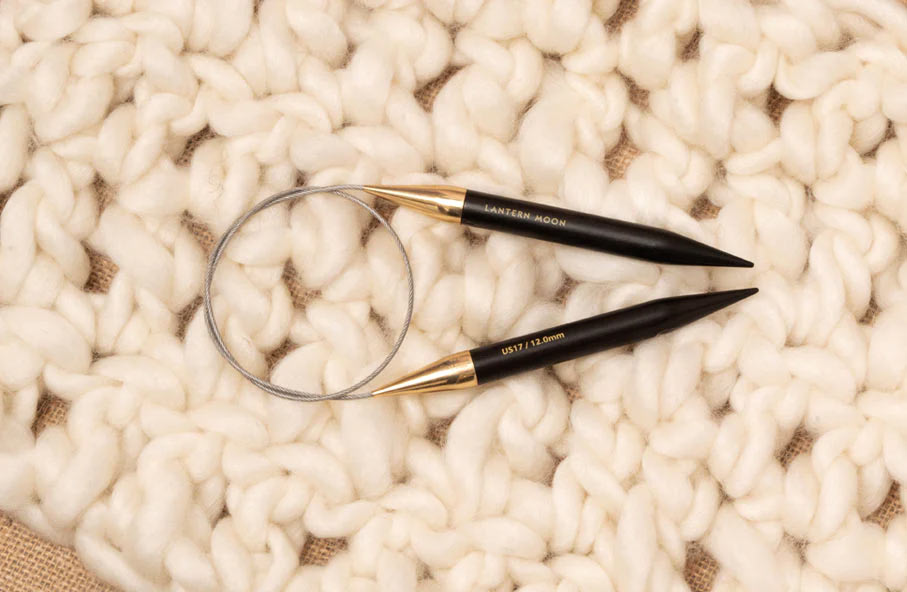
Knitting needles are diverse as the knitting community. With different needle types, sizes and lengths, each needle has a purpose and use in the crafting process. Most of us knitters learn to knit from a mentor, loved family member or friend with their borrowed needles. This is perfectly acceptable to learn the knit and purl stitches and even some beginner projects, it is crucial to understand your knitting needles to plan out your own projects in the future. In this blog, we’ll walk you through knitting needle sizes and lengths.
Why does Needle Size matter?
The general rule of thumb for knitting needles is bigger size = bigger stitches and smaller size = smaller stitches. The needle size is critical whenever you take up a project.
The needle size is calculated by its diameter. There are two measurements on most knitting needles, one in millimeters and one that usually says “US” and then a number. The sizes are standard whether it is a single-pointed needle or a circular tip (fixed and interchangeable) or a set of double points. Before you start any project first make sure you know which sizing convention your needle uses because a 5mm and a US 5 size needle are different.
Knitting Needle Lengths
Needle lengths are a different chapter. Each knitting needle has a length too. Single points are available in lengths of 10 - 14” and used for knitting projects in parts or dishcloths, etc.
Double pointed needles are available in lengths 6 & 8”, where 6” are preferred for socks, I-cords and projects with only a few stitches. 8” DPNs are used to knit hats, sleeves, necklines and other patterns. Refer to our guide on how to use double-pointed knitting needles.
The definition of needle lengths changes for circular. The length is calculated from one needle tip to the other including the cords. The needle tip is available in options of 4 & 5” while cords range from 8" to 49" accommodating blankets to a pair of socks. The interchangeable needles are a step ahead as the needle tips and cords can be switched according to the requirement of the project.
All knitting patterns suggest a needle size and yarn weight and a particular gauge. It is always recommended to knit a gauge swatch. Refer to our previous guide to know why gauge is important for knitting. To get the gauge, the needle size needs to be changed to a smaller size if you have lesser stitches and a bigger size if you have more stitches.
For our discussion on the needle sizes, we will be using the US sizes.
Knitting Needle Sizes
Sizes 0 -1 - Typically used for lace projects. These needle sizes work with delicate lace, fingering yarn and lightweight yarns.
Sizes 1 to 3 - Used to knit with sock weight, fingering and baby yarn. The needle sizes are used for socks, lace shawls and other delicate patterns.
Sizes 3 to 5 - Used to knit with sport-weight and baby yarns to make socks, sweaters, baby blankets, etc.
Sizes 5 to 7 - The perfect match for DK and light worsted-weight yarns, they are common in knitting anything from gloves to scarves to sweaters to blankets.
Sizes 7 to 9 - The most popular needle sizes, they are usually used to knit worsted-weight, Afghan & Aran yarns. These are recommended for new knitters.
Sizes 9 to 11 - Used to transform chunky-weight yarns, these needles are used for quick knitting projects with heavy yarns.
Sizes 11 to 17 - This size range is exclusively for chunky projects using bulky yarns. You will not find 12, 14, and 16 US needle sizes because these are only available in odd sizes (11, 13, 15 and 17).
Larger than 17 - These needle sizes are for jumbo-weight yarns for creating really thick knits.
Circular Knitting Needle Lengths
As we had discussed before, circular knitting needle lengths are game-changers. Fixed circular needles have a length that remains the same while interchangeable needles can be changed. The rule of thumb is that for knitting in the round with circular needles the needle length must be smaller than the project circumference. For knitting flat with circular needles, there is no rule besides that the cord can easily accommodate all the stitches.
Let’s take a look at cord lengths.
8-Inch - The cord makes 16" needles. Ideal lengths for knitting socks, narrow sleeves, baby hats, and other projects with very small circumferences.
10-Inch - The fixed circular 10" needles are perfect for knitting socks or small projects.
16-Inch - 16-inch cords and needles are ideal for all kinds of projects.
24-Inch - Used in almost all projects, especially shawlettes (smaller shawls), flat knit sweaters in pieces, baby cardigans, sweaters, etc.
29 to 32-Inch Cords - Perfect for knitting medium-sized projects in the flat or in-the-round knits. They are good fits for the body of sweaters, shawls, baby cardigans or blankets, and pullovers that are knit in the round. Say for instance, you have a project with 300+ stitches, this length can easily accommodate it without stressing your hands and wrists.
36 to 40-Inch Needle Cords - Ideal for large or heavy projects knitted flat. It is also the most popular option for small circumferences knitting using the magic loop. Refer to our guide on magic loop vs double pointed needles. They are also suitable for oversized circular shawls, cardigans, and sweaters that are knit in the round.
Over 40-Inch Needle Cords - Unless you are knitting substantial bed-size blankets, you won’t need them. You can use them when knitting the magic loop, but you will have to deal with the extra cord length, which can be very inconvenient.
In choosing needle size and lengths for any project, the application is the most important influencing factor but also your personal preferences. Yarn labels and knitting patterns guide you in making the choice but the gauge can help you make the right decision.
To have the right knitting needle explore the Lantern Moon Collection. The lanternmoon knitting needles are smooth, eco-friendly and has a unique inspirational word imprinted on them that assist knitters with enjoying the meditative aspects of knitting for beginner as well advanced knitters.
